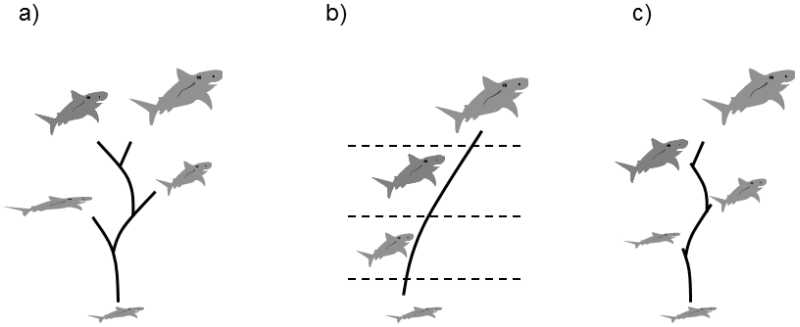XXII.1 True extinctions, dying out of species, are sometimes difficult to distinguish from pseudoextinctions, gradual anagenetic transformations of one species into a different species
Some authors include pseudoextinctions amongst extinctions (Fig. XXII.1).This term is used to

Fig. XXII.1 Extinction and pseudoextinction. In extinction, the population of a certain species physically dies out at a certain moment and thus also disappears from the paleontological record in the subsequent periods (a). In pseudoextinction, the particular species also disappears from the paleontological record; however, this happens only because its phenotype undergoes such substantial anagenetic changes that paleontologists begin to consider it to be a new species, called a chronospecies (b). The dashed line in figure (b) shows the boundaries between the individual chronospecies. However, in species with structured populations, there is no difference in principle and thus no sharp boundaries between extinction and pseudoextinction. A certain subpopulation of such a species can be transformed anagenetically to a new species, while other populations of individuals with the original phenotype can die out at approximately the same time (c). If the paleontological record does not contain populations of the old and new species existing next to one another for some time, the disappearance of the original species will probably be considered to correspond to pseudoextinction, even though, in fact, extinction will be involved.
designate the disappearance of a certain species from the paleontological record as a consequence of its gradual transformation into another species.The average phenotype of the members of a certain species gradually changed over time so that, after a certain time, it differed from the original phenotype to such a degree that paleotaxonomists begin to consider it to be a separate new species.Species delimited in this way are sometimes termed chronospecies.Basically, during pseudoextinction, the original species did not actually die out in the true sense of the word, but was only transformed into new species.In most taxa, true pseudoextinction is a rather rare phenomenon (see the sections concerned with punctuated evolution).Nonetheless, its existence must be taken into account.A considerable number of pseudoextinctions reflect the tendency of paleontologists to call a single species occurring in subsequent paleontological zones by different names.Completely different laws govern pseudoextinction than those of real extinctions and it will not be further considered in this chapter.
